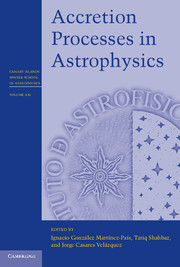Book contents
- Frontmatter
- Contents
- List of contributors
- List of participants
- Preface
- Acknowledgments
- Abbreviaions
- 1 Accretion disks
- 2 The evolution of binary systems
- 3 Accretion onto white dwarfs
- 4 Multiwavelength observations of accretion in low-mass X-ray binary systems
- 5 X-ray binary populations in galaxies
- 6 Observational characteristics of accretion onto black holes I
- 7 Observational characteristics of accretion onto black holes II: environment and feedback
- 8 Computing black-hole accretion
- A Piazzi Smyth, the Cape of Good Hope, Tenerife, and the siting of large telescopes
- References
3 - Accretion onto white dwarfs
Published online by Cambridge University Press: 05 January 2014
- Frontmatter
- Contents
- List of contributors
- List of participants
- Preface
- Acknowledgments
- Abbreviaions
- 1 Accretion disks
- 2 The evolution of binary systems
- 3 Accretion onto white dwarfs
- 4 Multiwavelength observations of accretion in low-mass X-ray binary systems
- 5 X-ray binary populations in galaxies
- 6 Observational characteristics of accretion onto black holes I
- 7 Observational characteristics of accretion onto black holes II: environment and feedback
- 8 Computing black-hole accretion
- A Piazzi Smyth, the Cape of Good Hope, Tenerife, and the siting of large telescopes
- References
Summary
3.1 Accretion from the ISM and winds
3.1.1 Introductory remarks on white dwarfs
The spectra of white dwarfs (WD) are classified according to the scheme devised by Sion et al. (1983), of which we need here to use only the types DA (with strong H lines), DB (with He I lines and no H), and DZ (metallic lines, e.g., Ca, but excluding C, subdivided into DAZ and DBZ). In addition, magnetic fields in WDs play important roles in accretion processes. Their occurrence in isolated form (or as members of noninteracting binaries) is observed by Zeeman splitting or polarization, and the distribution of field strengths appears bimodal: Wickramasinghe and Ferrario (2000, 2005) conclude that ~16% of WDs have strong fields (≥0.5 MG); a much smaller fraction have lower fields, but there are indications of a rise of up to 25% at the kG level.
3.1.2 Accretion from the ISM
Most isolated WDs are of type DA or DB, but a small fraction at the cool end of the WD sequence are of type DZ (Fig. 3.1). The reason for ignoring carbon in this spectral type is because it can be dredged up from the interior, whereas the other metals must have a different origin. Levitation by radiation pressure is not strong enough to keep metals in the atmospheres of such stars (for T < 40,000 K), and gravitational settling time scales are short compared with the cooling time scale, so the metals must have been delivered from outside the star – such as from the interstellar medium (ISM).
- Type
- Chapter
- Information
- Accretion Processes in Astrophysics , pp. 89 - 116Publisher: Cambridge University PressPrint publication year: 2014

